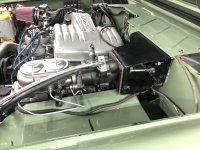jamesroney
Sr. Member
Thanks! I was thinking of coming over to visit your build...but it's going to be hotter than the surface of the sun this week.Yes, my config was inspired by Jon for sure!
James, I can measure and take a video for you today and text. Just got back from San Diego last night.
Mostly I need to know how far the pedal moves before the brakes "work" and then how far it goes when you push past that.
I'm guessing 2 inches to get it stopped, and 4 inches at the bottom. Which would leave about an inch of pedal to the floor if the brake pedal were in the right place, and 2 inches if you adjust it "tall" to be even with the clutch (if you had one...) at 6.5 inches off the floor.
I'm learning that Hydroboost doesn't exhibit pedal collapse like a vacuum booster. There's just a ton of pedal over-travel after the optimal braking effort has been achieved. I never saw it in my Cummins, because I never pushed the pedal super hard. I'm going to check that today.
I drove mine yesterday, and I can get full "face in windshield" braking at 1.5 inches of pedal travel. I can get 2.5 inches of "over-travel" before the pedal firms up. Turn out that in normal operation, I will never need to push the pedal that far. So there is some wierdness.
My only concern with short stroking the master cylinder is that you lose the redundant dual braking if you don't have enough pedal travel. 1 inch at the input piston is enough. (Since that is the amount that Ford put into the factory drum brake MC) GM master cylinders seem to have a little more travel. I would have to take apart this corvette MC to see where the transfer port is located, and just how much total travel is needed. My recent experience with a 1-1/8 GM cylinder is that it is hard to bleed the rear brake circuit with less than 1 full inch of travel.
Once I built the new bellcrank, and gave myself 1.25 of travel, the brake bled normally, and the MC behaved like it should. And yes...this thing has vastly "better" brakes.











